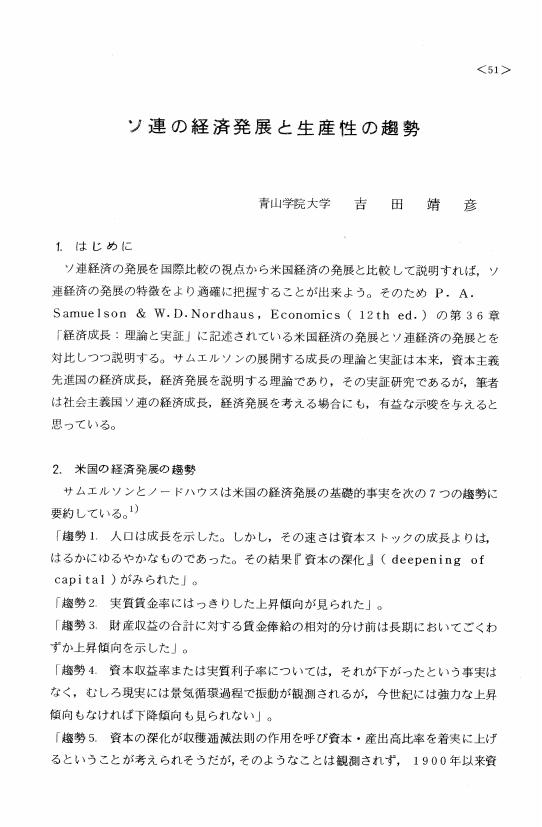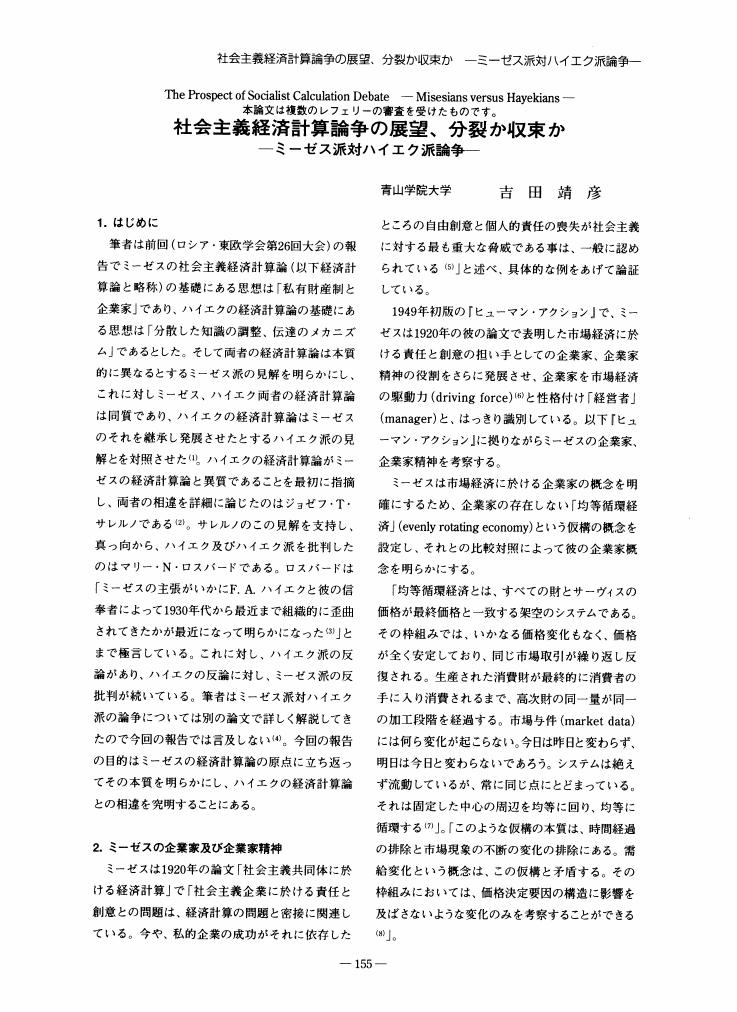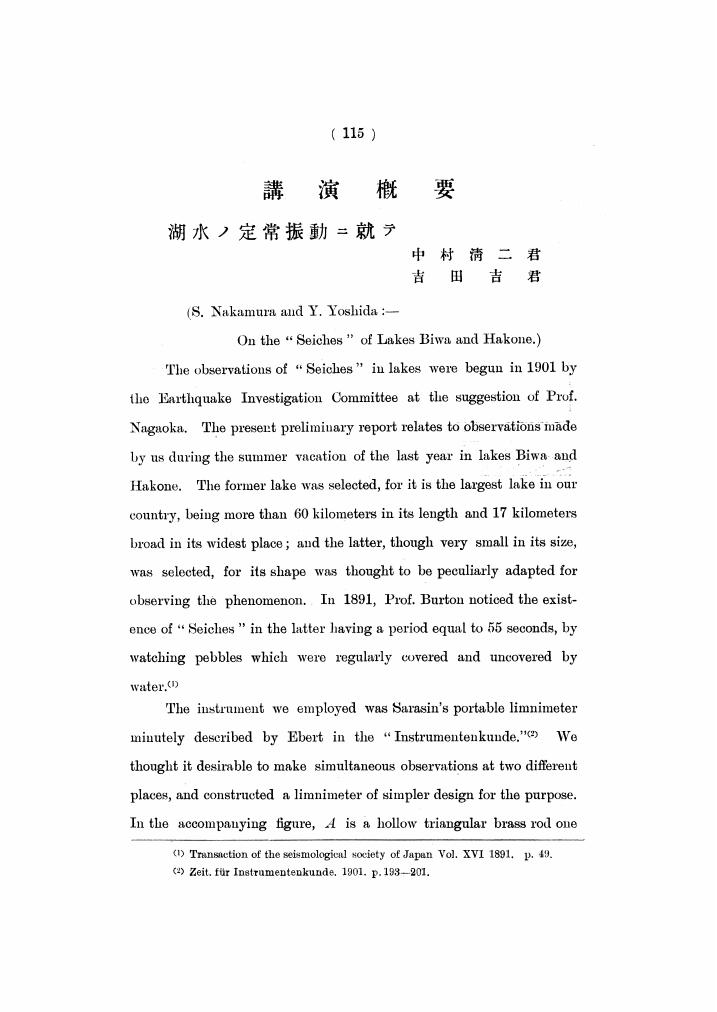1 0 0 0 OA 明星聖子 著 『新しいカフカ ―「編集」が変えるテクスト ―』
- 著者
- 吉田 芳弘
- 出版者
- 日本独文学会
- 雑誌
- Neue Beiträge zur Germanistik (ISSN:24330906)
- 巻号頁・発行日
- vol.115, pp.171-174, 2004-03-15 (Released:2018-03-31)
1 0 0 0 OA 拡大するロシアと北東アジア ―経済的側面を主として―
- 著者
- 吉田 進
- 出版者
- ロシア・東欧学会
- 雑誌
- ロシア・東欧研究 (ISSN:13486497)
- 巻号頁・発行日
- vol.2007, no.36, pp.30-47, 2007 (Released:2010-05-31)
In this paper, firstly, I have shed light on Russia's economic revival, and the rise in the standard of living of the general public, the political stability and the energy diplomacy, etc., which it has brought about.In particular, I have expounded in detail on the “Federal Target Program for the Economic and Social Development of the Far East and Zabaikal Region”—the development program for the Russian Far East and East Siberia, with their profound relationships with the Northeast Asian region—and the redevelopment in Vladivostok for the 2012 APEC summit.Then I have touched upon the perception of Russia as seen from East Asia, a comparison of the economies of each of the countries concerned, and the trends for trade vis-à-vis Russia for the countries of Northeast Asia. Additionally I have analyzed the history of economic interchange between Russia and the nations of Northeast Asia, the current state of affairs and problem areas.Next I have covered the mutual interdependence of Russia and the Northeast Asian region for the following; mutual cooperation through international organizations cooperating internationally, such as, the Greater Tumen Initiative Consultative Commission, the Shanghai Cooperation Organization, and the six-party talks on the DPRK's problems, plus the cooperative relationships in the areas of energy, environmental protection, transportation corridors, investment and trade, and finance.Within such a format I have comprehensively discussed the economic relationships between Russia and Northeast Asia, and have endeavored to illuminate the future path of the Northeast Asia Economic Subregion.This is a lecture of 20 October 2007, with additions and amendments.
- 著者
- 吉田 裕季
- 出版者
- ロシア・東欧学会
- 雑誌
- ロシア・東欧研究 (ISSN:13486497)
- 巻号頁・発行日
- vol.2005, no.34, pp.157-167, 2005 (Released:2010-05-31)
The Military convention of Belgrade was concluded between the Allies and Hungary when the First World War came to an end. This convention established the boundary line on the southeast part of Hungary. But this boundary line was violated by the Rumanian Army which crossed it from Transylvania on 15th December, 1918. Later, this line was modified in favor of Rumania.About that time the Ukrainian invasion started under the initiative of the French Army. The French Army was obviously defeated owing to a shortage of forces.Some historians argued that the Ukrainian invasion had an influence on the amendment of the boundary line. They explained that the French policies took a measure in favor of Rumania, because they wished the supplement of the shortages of forces by the Rumanian Army, accepting the territorial demands of Rumania as compensation.The purpose of this article is to explain in view of the Ukrainian invasion why the amendment of the line was realized in favor of Rumania.The first chapter makes clear the significances of the Military convention of Belgrade for Hungary, France and Rumania. This convention should accept the Hungarian territorial demands and contribute to extend the French influence on Central Europe through the occupation of Hungary. But for Rumania it would hinder her territorial claims.The second chapter makes evident through the process of the Ukrainian invasion the factors related with the amendment of the boundary line. It is quite obvious that the French Army was not enough to invade Ukraine, therefore the military authorities suggested to make a profit from the Rumanian Army. The French Army without the indigenous inhabitant's cooperation was overpowered by the Bolshevik Army. For this reason an anti-Bolshevik policy was increasingly regarded as necessary. Besides the Rumanian government had indicated her intentions to render some military services in Russia.The third chapter concerns influence of the Ukrainian invasion on the amendment of the boundary line through the discussions on the revision in the Peace Conference. There was an atmosphere in the chamber that one should defend the benefits of the Allies. Therefore on the one hand, the demands of Rumania were approved, on the other, the claims of a hostile country, Hungary, were rejected. However it remarked that France proposed to recognize Rumania as an Ally, and submitted the draft for the amendment of the line. Besides the fact that Rumania let her army march across the boundary line to make fait accompli might have served to accord her territorial demands. The French Army, however, did not occupy Hungary, for it considered that this circumstance would permit the Rumanian Army to advance.Therefore, the French policies must be emphasized as a factor of the amendment of the boundary line in favor of Rumania. In this case, however, a great importance should be attached to not only the shortages of forces, but also to the anti-Bolshevik policy and it should be also taken into consideration that an anti-Bolshevik attitude of Rumania proved to be favorable for France. With reference to the amendment of the boundary line, this policy has not been argued enough until today.
1 0 0 0 OA 社会主義経済計算論争再考
- 著者
- 吉田 靖彦
- 出版者
- ロシア・東欧学会
- 雑誌
- ソ連・東欧学会年報 (ISSN:03867226)
- 巻号頁・発行日
- vol.1991, no.20, pp.52-61, 1991 (Released:2010-05-31)
1 0 0 0 OA ソ連と日本の産業部門別生産性趨勢の比較
- 著者
- 福原 文雄 吉田 靖彦
- 出版者
- ロシア・東欧学会
- 雑誌
- ソ連・東欧学会年報 (ISSN:03867226)
- 巻号頁・発行日
- vol.1989, no.18, pp.41-49, 1989 (Released:2010-05-31)
1 0 0 0 OA ソ連の経済発展と生産性の趨勢
- 著者
- 吉田 靖彦
- 出版者
- THE JAPANESE ASSOCIATION FOR RUSSIAN AND EAST EUROPEAN STUDIES
- 雑誌
- ソ連・東欧学会年報 (ISSN:03867226)
- 巻号頁・発行日
- vol.1988, no.17, pp.51-76, 1988 (Released:2010-03-16)
- 参考文献数
- 6
1 0 0 0 OA ソ連農業における私的部門について
- 著者
- 吉田 靖彦
- 出版者
- THE JAPANESE ASSOCIATION FOR RUSSIAN AND EAST EUROPEAN STUDIES
- 雑誌
- ソ連・東欧学会年報 (ISSN:03867226)
- 巻号頁・発行日
- vol.1980, no.9, pp.113-132, 1980 (Released:2010-03-16)
- 参考文献数
- 12
1 0 0 0 OA ソ連農業と技術進歩
- 著者
- 吉田 靖彦 福原 文雄
- 出版者
- THE JAPANESE ASSOCIATION FOR RUSSIAN AND EAST EUROPEAN STUDIES
- 雑誌
- ソ連・東欧学会年報 (ISSN:03867226)
- 巻号頁・発行日
- vol.1976, no.5, pp.122-145, 1976 (Released:2010-03-16)
- 参考文献数
- 12
1 0 0 0 OA ソ連の経済改革 その評価と展望
1 0 0 0 OA 社会主義経済計算論争の展望、分裂か収束か ―ミーゼス派対ハイエク派論争―
- 著者
- 吉田 靖彦
- 出版者
- ロシア・東欧学会
- 雑誌
- ロシア・東欧学会年報 (ISSN:21854645)
- 巻号頁・発行日
- vol.1999, no.28, pp.155-165, 1999 (Released:2010-05-31)
- 参考文献数
- 36
1 0 0 0 OA 社会主義経済計算論争の発展 ―ミーゼス派対ハイエク派論争を中心として―
- 著者
- 吉田 靖彦
- 出版者
- ロシア・東欧学会
- 雑誌
- ロシア・東欧学会年報 (ISSN:21854645)
- 巻号頁・発行日
- vol.1997, no.26, pp.91-101, 1997 (Released:2010-05-31)
- 参考文献数
- 43
1 0 0 0 OA 社会主義経済計算論争の再検討
- 著者
- 吉田 靖彦
- 出版者
- ロシア・東欧学会
- 雑誌
- ロシア・東欧学会年報 (ISSN:21854645)
- 巻号頁・発行日
- vol.1993, no.22, pp.76-83, 1993 (Released:2010-05-31)
- 参考文献数
- 39
1 0 0 0 OA 験潮器の記録に表はるる小波動に就て
- 著者
- 本多 光太郎 吉田 吉 寺田 寅彦
- 出版者
- 一般社団法人 日本物理学会、一般社団法人 日本数学会
- 雑誌
- Tokyo Sugaku-Butsurigakukwai Kiji-Gaiyo (ISSN:21852685)
- 巻号頁・発行日
- vol.2, no.16, pp.222-232, 1904 (Released:2006-03-27)
- 参考文献数
- 7
1 0 0 0 OA Mark Twainの作品にみられる"核"と"触媒"の相関関係について
- 著者
- 吉田 真理子
- 出版者
- 英米文化学会
- 雑誌
- 現代英米文化 (ISSN:24330728)
- 巻号頁・発行日
- vol.17, pp.50-61, 1987-02-28 (Released:2017-09-07)
1 0 0 0 OA 驗潮器ノ記録ニ表ハル丶小波動ニ就テ
- 著者
- 本多 光太郎 吉田 吉 寺田 寅彦
- 出版者
- 一般社団法人 日本物理学会、一般社団法人 日本数学会
- 雑誌
- Tokyo Sugaku-Butsurigakkwai Hokoku (ISSN:21852677)
- 巻号頁・発行日
- vol.2, no.17, pp.222-232, 1903 (Released:2010-03-16)
- 参考文献数
- 7
1 0 0 0 OA 湖水ノ定常振動ニ就テ
- 著者
- 中村 清二 吉田 吉
- 出版者
- 一般社団法人 日本物理学会、一般社団法人 日本数学会
- 雑誌
- Tokyo Sugaku-Butsurigakkwai Hokoku (ISSN:21852677)
- 巻号頁・発行日
- vol.1, pp.F115-F123, 1901 (Released:2010-03-16)
- 参考文献数
- 3
- 著者
- 吉澤 寛之 吉田 俊和 中島 誠 吉田 琢哉 原田 知佳
- 出版者
- 日本応用心理学会
- 雑誌
- 応用心理学研究 (ISSN:03874605)
- 巻号頁・発行日
- vol.45, no.1, pp.35-46, 2019-07-31 (Released:2019-10-31)
- 参考文献数
- 33
- 被引用文献数
- 1
The authors examined the effects of neighborhood commitment and atmosphere on antisociality as mediated by collective efficacy (CE) using a multilevel analysis. Stratified sampling was used to collect data from 3,451 students and 545 teachers from 26 junior high schools in 4 qualitatively different communities. CE was indicated by students based on their perceptions of neighborhood "informal social control" (ISC) and "social cohesion and trust" (SCT) in their communities and their social information processing denoted antisociality. Teachers assessed the antecedent indices regarding the community environments within their school districts. Multilevel structural equation modeling was used to analyze the neighborhood-level effects of the antecedents on antisociality via CE. The results revealed that antecedents indirectly inhibited antisociality via ISC at the neighborhood-level. SCT directly inhibited antisociality at the individual-level. Implications for community interventions were discussed.
1 0 0 0 OA 公務員の労働権
- 著者
- 吉田 豊信
- 出版者
- 日本行政学会
- 雑誌
- 行政研究叢書 (ISSN:2187039X)
- 巻号頁・発行日
- vol.1958, no.3, pp.123-132, 1958-04-07 (Released:2012-09-24)
1 0 0 0 OA シンポジウム 古代オリエントにおける奴隷の問題
1 0 0 0 OA 韓非の勢 : 難勢編を手掛かりとして
- 著者
- 吉田 浤一
- 出版者
- 静岡大学教育学部
- 雑誌
- 静岡大学教育学部研究報告. 人文・社会・自然科学篇 (ISSN:18843492)
- 巻号頁・発行日
- vol.62, pp.25-50, 2012-03















